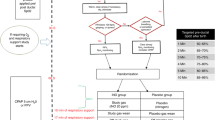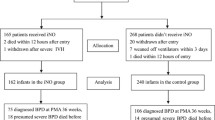Abstract
The response to three levels (10 ppm, 20 ppm and 40 ppm) of nitric oxide (NO) was assessed in 30 infants, median gestational age 30 (range 24–42) weeks. All the infants required an inspired oxygen concentration of more than 0.5, despite receiving surfactant where appropriate. All but one infant had a positive response to NO (median reduction in the oxygenation index (OI) was 33%, range −9%–90%), but only 20 infants showed a greater than 20% reduction in the OI. There was no obvious relationship of the optimum NO level (i.e. that associated with the maximum reduction in OI) and either diagnosis (congenital diaphragmatic hernia, meconium aspiration syndrome, respiratory distress syndrome, pulmonary interstitial emphysema (PIE), hydrops and sepsis) or maturity, except that five of six infants with PIE responded best to 40 ppm, as did eight of nine infants less than 28 weeks gestational age. We conclude NO dosage should be individualized and NO levels up to 40 ppm should be considered in very immature infants.
Similar content being viewed by others
Author information
Authors and Affiliations
Additional information
Received: 15 March 1996 / Accepted: 5 February 1997
Rights and permissions
About this article
Cite this article
Laubscher, B., Greenough, A., Kavvadia, V. et al. Response to nitric oxide in term and preterm infants. Eur J Pediatr 156, 639–642 (1997). https://doi.org/10.1007/s004310050682
Issue Date:
DOI: https://doi.org/10.1007/s004310050682




